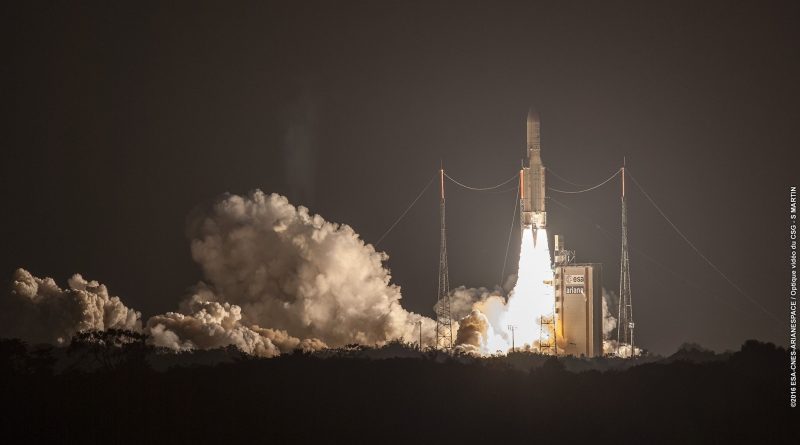Intelsat Pair lifted into Orbit in Record-Setting Ariane 5 Launch
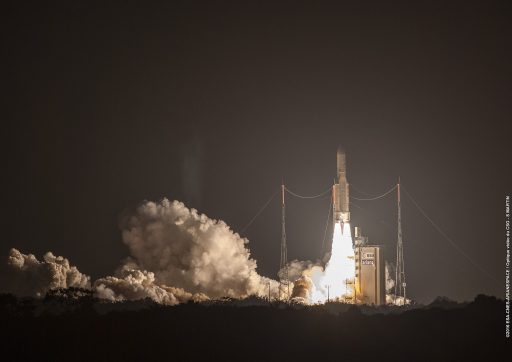
Lighting up the night at the edge of the Amazon, Europe’s Ariane 5 rocket boosted a heavy pair of Intelsat communications satellites into orbit on Wednesday and in the process pushed its record for the heaviest payload delivered to Geostationary Transfer Orbit.
The 55-meter tall Ariane 5 thundered off from the Guiana Space Center at 22:16 UTC under the rumble of its powerful cryogenic main engine and twin Solid Rocket Boosters. Powering uphill with the equivalent power to ten Airbus A380 aircraft at full throttle, Ariane 5 swung to a due easterly flight path for a 20-minute flight across the Atlantic.
The liftoff came after a clean 11.5-hour countdown from a technical standpoint, but the T-0 time had to be pushed from a 21:55 UTC window opening due to a boat that entered the launch hazard area off the coast, causing a range-related hold of 21 minutes.
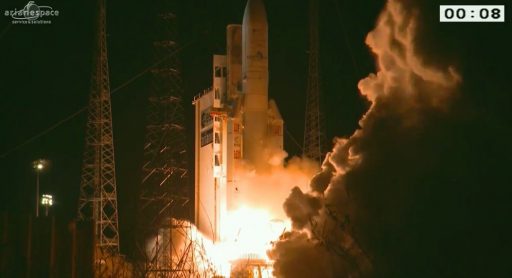
Arcing into partly cloudy skies over its equatorial launch site, Ariane 5 reached the speed of sound within 49 seconds of liftoff, relying on its boosters to deliver over 90% of the rocket’s total thrust of 1,420 metric-ton-force. The launcher dropped its boosters two minutes and 22 seconds into the flight, having reached a speed of two Kilometers per second and an altitude of 70 Kilometers.
With the boosters gone, Ariane 5 relied on its Vulcain 2 engine alone, guzzling down 300 Kilograms of supercold cryogenic propellants per second to generate 136,000 Kilogram-force of thrust when flying through the rarefied upper atmosphere. As soon as the rocket had left the discernible atmosphere, it separated its 17-meter long payload fairing, revealing the Intelsat 33e satellite, the larger of the two passengers, while Intelsat 36 remained hidden underneath the Sylda adapter.
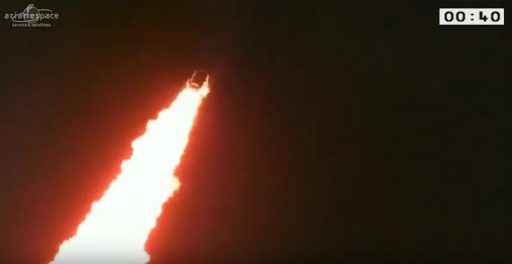
The first stage shut down its engine just shy of T+9 minutes, having placed the stack onto a sub-orbital flight path peaking at 165 Kilometers in altitude. Stage separation occurred shortly after shutdown, clearing the way for ignition of the ESC-A’s HM-7B engine on a burn of 16 minutes to push the stack into orbit.
The two U.S.-built satellites received a smooth ride on the rocket’s second stage, generating 6,400 Kilogram-force of thrust to accelerate the stack to an injection speed of 9.4 Kilometers per second. The VA232 mission aimed for a highly elliptical orbit of 250 by 35,879 Kilometers, inclined 6.0 degrees to the equator.
After reaching the African coastline, the second stage set up for the deployment of this mission’s passengers – the Boeing-built Intelsat 33e and Intelsat 36 that was manufactured by Space Systems Loral.
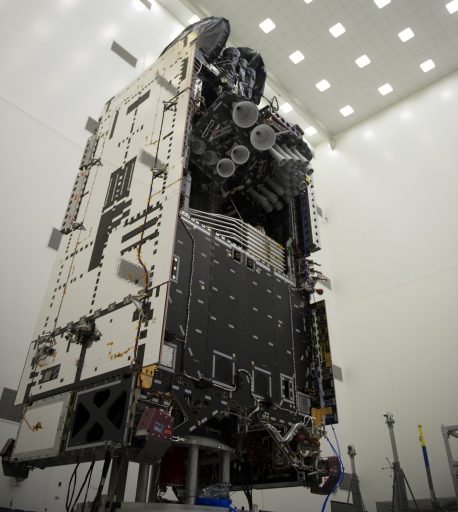
Intelsat 33e departed the launch vehicle 29 minutes after liftoff to begin its 15-year mission with a series of maneuvers to lift itself from an elliptical orbit to its operational slot in Geostationary Orbit where the satellite’s speed matches that of the rotation of the Earth so that the spacecraft remains centered over its coverage area.
Weighing in at 6,575 Kilograms, Intelsat-33e is based on Boeing’s BSS-702MP satellite platform, outfitted with a powerful Ku/C-Band payload that can support a data throughput of 25 gigabits per second.
The satellite is the second in Intelsat’s Epic architecture that deploys C-, Ka- and Ku-Band payloads to orbit to deliver flexible services through a combination of wide beams and spot beams as well as frequency reuse.
Intelsat 33e replaces the Intelsat 904 satellite at 60° East to expand capabilities and ensure service continuity. Services delivered by the satellite include carrier-grade telecom, enterprise services and aeronautical connectivity via global C-Band beams and high-powered Ku-Band spotbeams.
>>Intelsat 33e Technical Overview
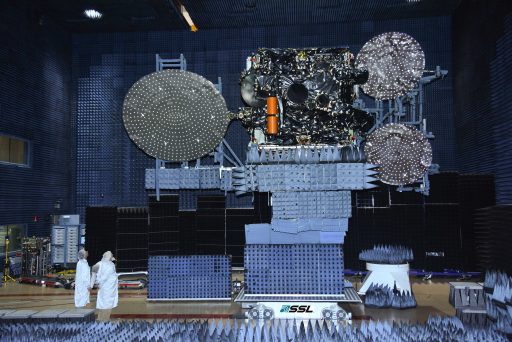
The Intelsat 36 satellite – affixed to the launcher’s second stage and hidden under the Sylda adapter for the powered phase of the flight – was revealed when Sylda was jettisoned to set up for its separation 42 minutes after launch. Drifting away from the Ariane 5 second stage, the 3,253-Kilogram spacecraft will aim for a position at 68.5° East where it joins the Intelsat 20 satellite to increase coverage from Intelsat’s premier Direct-To-Home (DTH) neighborhood in Africa.
The satellite’s 30 Ku-Band transponders have been sold to MultiChoice, a leading pay TV provider in Africa, while ten C-Band transponders are available to deliver TV distribution to markets in Africa and Asia.
With both satellites safely on their way, Ariane’s second stage completed passivation after a job well done. Wednesday’s launch pushed Ariane’s GTO payload record to 10,735 Kilograms – an increase of five Kilograms over the previous record set earlier this year. Even as a mature launcher with two decades of operation, Ariane 5 continues to undergo optimization such as mass reduction to increase the mass it can boost into orbit as evident in the growing payload masses lofted by the workhorse.
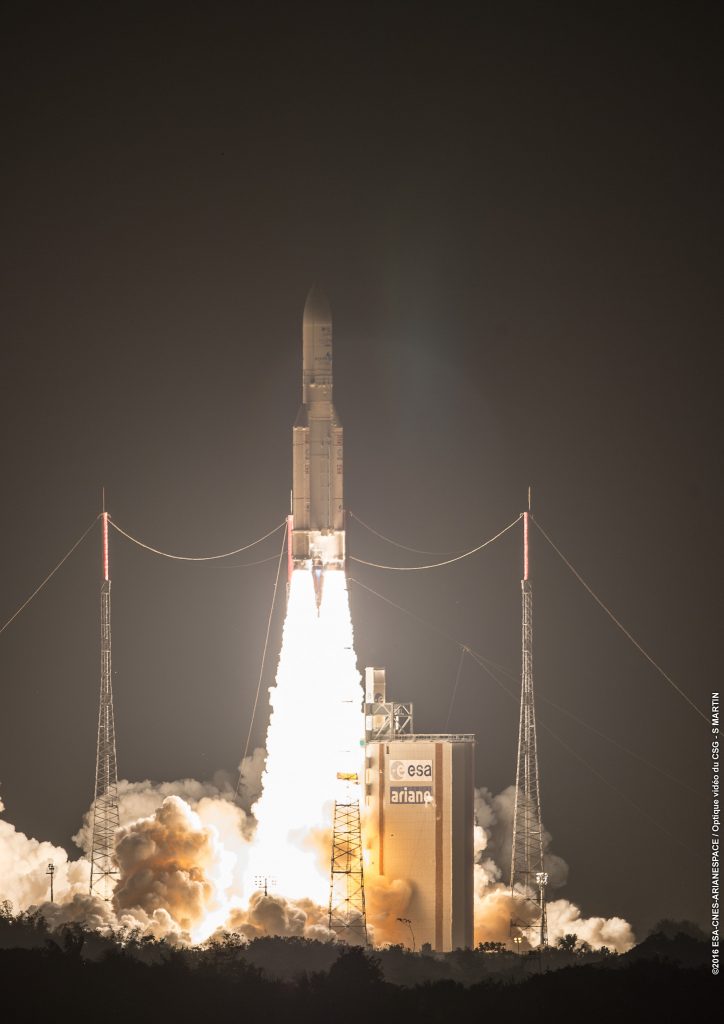
Both satellites checked in with their respective ground stations after separating from the booster and are currently in operation by their manufacturers that will guide the spacecraft to their planned locations in GEO and complete testing before turning the satellites over to their operator.
Wednesday’s launch marked the 231st launch of an Ariane rocket in a program that premiered in 1979, it was the 87th flight of the Ariane 5, the 57th using the ECA configuration and the fourth in 2016.
It was the 73rd successful Ariane 5 launch in a streak that continues since 2003.
Intelsat 33e and 36 are the third and fourth satellites launched by the telecommunications giant this year after the successful deployments of the Intelsat-29e satellite by an Ariane 5 rocket in January and Intelsat 31 that was lifted by a Russian Proton rocket in June. A single Intelsat launch is currently expected in 2017 and two satellites are scheduled to be launched in 2018.
For Arianespace, the next mission will feature the light-lift Vega rocket blasting off on September 16 with the PeruSat-1 Earth Observation satellite and four SkySat imaging satellites to continue the deployment of Terra Bella’s operational constellation. Ariane 5 will see action again in early October with the VA231 mission that lifts the Indian GSAT-18 communications satellite and NBN CO 1B, the second in a constellation of communications satellites covering remote areas of Australia.

